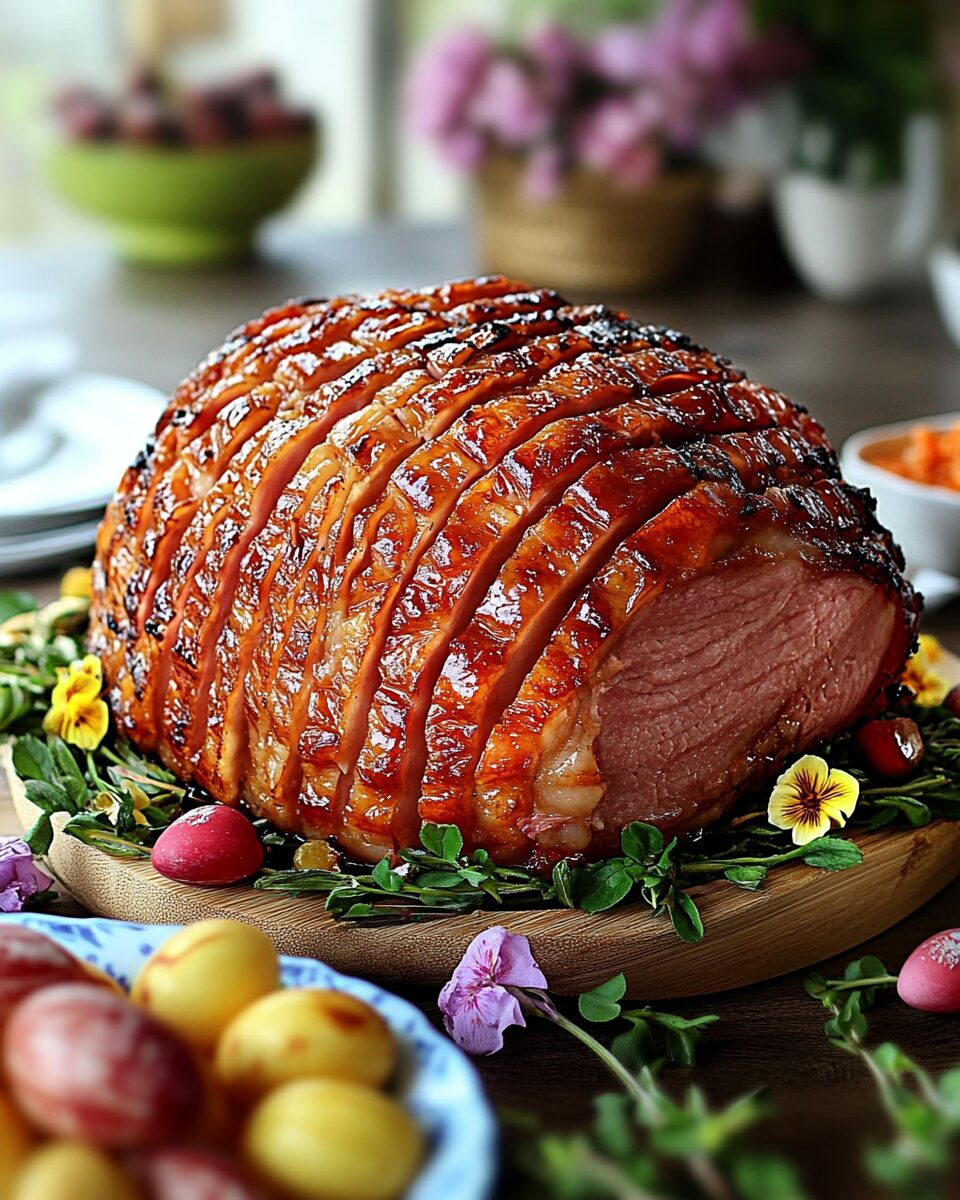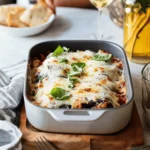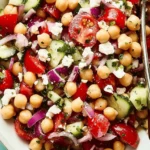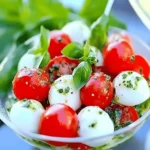This Glazed Easter Ham is a delightful centerpiece for your holiday table. The sweet and tangy glaze, featuring a surprising ingredient, Dr Pepper or Coke, adds a glossy finish and rich flavor to the fully cooked bone-in ham. Perfect for gatherings, this recipe ensures a moist and flavorful ham that will impress your guests.
FULL RECIPE:
Ingredients
- 1 whole fully cooked bone-in ham (15 to 18 pounds)
- Whole cloves
- 3 cups brown sugar
- 1/2 cup spicy brown mustard
- 1 can Dr Pepper or Coke
- 3 tablespoons apple cider vinegar
Directions
- Preheat the oven to 325°F.
- Score the surface of the ham in a diamond pattern about 1/8-inch deep. Place a clove in the center of each diamond.
- Place the ham on a rack in a large roasting pan. Tent it with foil and bake for 2 to 2 1/2 hours, or longer, depending on the package directions.
- In a small saucepan, combine the brown sugar, mustard, vinegar, and soda. Heat until bubbly and cook until reduced and slightly thickened, about 15 minutes.
- After about 2 hours of baking, remove the foil and brush the glaze over the ham. Continue baking, uncovered, brushing with additional glaze every 20 minutes until the ham is glossy.
- Remove from the oven and let rest for 15 to 20 minutes before carving.
Nutrients
- Calories: Approximately 450
- Protein: Approximately 30 grams
- Fat: Approximately 20 grams
- Carbohydrates: Approximately 30 grams
- Sodium: Approximately 2,500 milligrams
- Sugar: Approximately 27 grams
The History and Tradition of Easter Ham
Ham has been a staple of Easter celebrations for centuries. The tradition of serving ham during Easter stems from practicality—before refrigeration, early American settlers would cure pork in the winter, and by the time spring arrived, the meat was ready to be eaten. This made ham the natural choice for Easter feasts. Over time, different cultures have added their own unique twists to this dish, from honey glazes to fruit-based marinades, making it a worldwide holiday favorite. In Europe, ham is also associated with ancient pagan festivals celebrating the arrival of spring. The practice of consuming pork during springtime feasts dates back to early Germanic and Scandinavian traditions.
What Makes This Glazed Easter Ham Special?
This recipe stands out because of its sweet and tangy glaze, which features a unique ingredient: Dr Pepper or Coca-Cola. While it may sound unconventional, the soda’s caramelized sugar, combined with brown sugar, mustard, and apple cider vinegar, creates an irresistible flavor that enhances the natural saltiness of the ham. Using soda as a glaze base is a Southern-inspired technique that adds depth and a glossy finish to the ham. The combination of sweet, spicy, and acidic flavors ensures a balance that prevents the ham from tasting too rich or overly salty. Unlike traditional glazes that rely solely on honey or maple syrup, this recipe brings out the juiciness of the ham while adding an unexpected, complex sweetness.
Choosing the Right Ham for the Recipe
When selecting a ham, there are two main types to consider:
- Bone-in ham: This is the best option for maximum flavor and moisture. The bone adds depth to the taste and can be used later to make soups or broths.
- Boneless ham: Easier to carve and serve but may lack the deep, rich flavor of bone-in ham.
For this recipe, a fully cooked, bone-in ham is recommended. This ensures a juicy texture and allows the glaze to penetrate the meat while roasting. Additionally, a spiral-cut ham makes serving easier, as the slices allow the glaze to seep into every crevice.
The Role of Cloves in Glazed Ham
One of the key ingredients in this recipe is whole cloves. Cloves have been used in ham preparations for centuries due to their strong aroma and slightly sweet-spicy taste. They not only provide a festive appearance but also enhance the ham’s overall depth of flavor. When inserted into the ham, cloves release their oils into the meat, creating a warm, aromatic infusion. However, they should be removed before eating, as their intense flavor can be overpowering if bitten into directly.
Cooking Techniques for the Perfect Ham
Achieving the perfect Glazed Easter Ham requires careful temperature control and proper glazing techniques. Here are some important tips to ensure the best results:
- Baking at the Right Temperature: The ham should be cooked at 325°F (163°C) to allow for even heating without drying out.
- Tent with Foil: Covering the ham with foil during the initial baking process prevents it from losing moisture.
- Glazing at the Right Time: Applying the glaze too early can result in burnt sugar. Instead, glaze the ham during the final 30 minutes of cooking for a beautifully caramelized finish.
- Resting Period: Allow the ham to rest for at least 15 minutes after baking. This step helps the juices redistribute within the meat, making each bite succulent.
Why This Ham Recipe Is Perfect for Easter Gatherings
This Glazed Easter Ham is ideal for large family gatherings and holiday celebrations for several reasons:
- Feeds a Crowd: A 15-18 pound ham can serve anywhere from 12 to 18 people, making it a cost-effective dish for a large party.
- Easy to Prepare: Since the ham is already fully cooked, most of the work is simply glazing and reheating, which frees up time for preparing side dishes or entertaining guests.
- Pairs Well with Various Side Dishes: The sweet and savory flavor profile of this ham complements classic Easter sides such as scalloped potatoes, roasted carrots, green beans, and cornbread.
- Great for Leftovers: Leftover ham can be used in sandwiches, omelets, casseroles, and soups, reducing food waste and offering delicious meals for days after the holiday.
Pairing the Ham with Side Dishes and Drinks
To elevate your Easter dinner, consider pairing your Glazed Easter Ham with complementary side dishes and beverages.
Recommended Side Dishes
- Scalloped Potatoes – The creamy, cheesy texture balances the sweetness of the ham.
- Honey Glazed Carrots – A perfect side that mirrors the sweetness of the glaze.
- Green Bean Almondine – A light, nutty, and buttery vegetable dish to balance the rich flavors.
- Cornbread or Dinner Rolls – Soft and fluffy bread options help soak up the delicious glaze.
- Deviled Eggs – A classic Easter favorite that adds a creamy, tangy contrast.
Beverage Pairings
- Sparkling Apple Cider – The crisp acidity helps cut through the richness of the ham.
- White Wine (Riesling or Chardonnay) – A slightly sweet or oaky white wine complements the glaze beautifully.
- Homemade Lemonade – A refreshing, citrusy drink that balances out the meal.
- Iced Tea – Southern-style sweet tea pairs well with the Dr Pepper/Coca-Cola-infused glaze.
Using Leftover Ham in Other Dishes
One of the best things about making a large Easter ham is having leftovers that can be repurposed into multiple meals. Here are some ideas:
- Ham and Cheese Omelet – Chop up leftover ham and add it to scrambled eggs with cheese for a protein-packed breakfast.
- Ham and Potato Soup – Simmer ham with potatoes, onions, and broth for a comforting meal.
- Ham Sandwiches – Layer thin slices of ham with mustard and Swiss cheese for a classic deli-style sandwich.
- Ham and Pea Pasta – Toss ham with pasta, cream sauce, and peas for a quick and creamy dinner.
- Ham and Pineapple Pizza – Add ham and pineapple to a homemade pizza for a sweet and savory combination.
Conclusion
A Glazed Easter Ham is more than just a holiday meal—it’s a symbol of tradition, celebration, and togetherness. This recipe stands out with its unique soda-infused glaze, which enhances the natural flavors of the ham while adding a beautiful, glossy finish. Whether you’re hosting a large gathering or simply looking for a reliable holiday centerpiece, this dish delivers on flavor, ease, and versatility.






